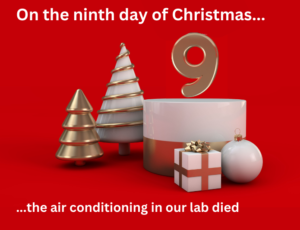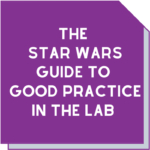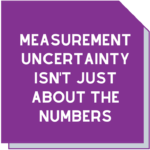12 Days of a Lab Christmas – Day 9
written by Maree Stuart
As we head into the silly season we are delighted to present:
The MAS Management Systems 12 Days of a Lab Christmas!

On the ninth day of Christmas, the air conditioning in our lab died
If you’re in Melbourne right now, then dealing with hot temperatures hasn’t exactly been a recent issue. But that won’t always be the way.
We install air conditioning in our lab spaces generally for two reasons: for maintaining staff comfort or because the test methods or equipment specifications require a regulated operating environment. Working out which reason you have air conditioning will help whether the lack of air conditioning is a big or a small issue.
Of course, we know you’ll choose staff comfort as a big issue 😊
How to work out if it’s a big issue
This is where your experience and professional judgement comes to the fore!
The first place to look to is often external reference points. Look at things that you may have glossed over, like equipment performance specifications and reference test or calibration methods. If these documents prescribe an operating temperature of 20 – 25oC and you’ve already got the temperature up to 30oC, then you have a significant problem.
Of course, sometimes it’s not specified in the method or equipment manual. What do you know as an experienced lab person in terms of the influence of temperature on the results?
If it’s really a staff comfort reason, think about what this does to the ability of your staff to perform the tests or calibrations reliably, accurately and precisely. Are your staff made of stern stuff, resilient to things like temperature changes or are they more sensitive to temperature variations and distractions arising from that?
If it’s the latter, then you’ll need to do something! And what that something is will depend on your attitude and the culture of your lab.
The next step is to decide what you’re going to do about it.
Don’t Panic!
This is where the tried-and-true non-conformance/corrective action process is your friend. Lean into the problem and don’t shy away from doing the usual things like documenting it and doing both correction and corrective action.
First of all, the continuing functionality of the air conditioning is a RISK. You might not have identified this previously but that doesn’t mean you shouldn’t run it through the risk management process.
- Identify the risk (you’ve already done that because it’s happened)
- Analyse the risk, both in terms of likelihood and consequence. Remember, if it’s happened, it’s not an unlikely event!
- Evaluate or rank the risk
- Determine actions
- Implement and monitor the effectiveness of any risk controls
In terms of correction vs corrective action, consider if it means you have to stop testing or move the testing to an area where the environmental conditions can be controlled. Obviously, you’ll need to fix the air conditioning and that might take a while.
How the standards can help you
If you take a look at ISO 17025 and ISO 15189, you’ll find that there are actually requirements for environmental conditions. They are not specific, but they do draw attention to the need to identify suitable environmental conditions. There is also the requirement to monitor and control these so they don’t invalidate the results or adversely affect the required quality of any testing or calibration.
Just because you might have taken lab temperature for granted, the event and any deviation from all suitable environmental conditions should give you a prompt to look at this a little more closely. The standards point to factors such as light, sterility, dust, noxious or hazardous fumes, electromagnetic interference, radiation, humidity, electrical supply, temperature, sound and vibration levels and workflow logistics. Now is the time to examine these factors.
What if you don’t know if it’s important?
Well, that means you might need to talk to someone who knows! You could consult an expert in the test or technique. A colleague in another lab or in academia might be able to help you.
You always have your QC data and your MU budget to help you understand the impact. If you have continued testing while environmental conditions are not optimal, then keep an eye on what your QC data is telling you. Are QC results outside of the acceptable limits or moving towards those limits?
If you do find it is a significant factor, then go back and look at your MU budget and whether your MU estimate should take this into account. Perhaps you need to improve your estimate by including it as a factor contributing to MU.
Of course, the main thing to remember if you really don’t know what to do is you don’t have to do this alone!
We’re happy to help you work through tricky conundrums just like this! Reach out to Maree at maree@masmanagementsystems.com.au, or call her on 0411 540 709 to help put you in the right direction.





